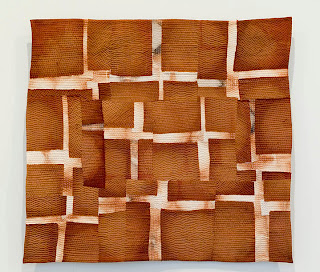I'm writing this in response to Ruth's comments to my Post, 'Wunderkammer/Wundernet' (August 28). Ruth asked certain questions which have helped me clarify my thoughts and the reasons why I made the link between Pamela's Lost birds series and the wunderkammer/cabinet of curiosities and here are some of my answers:
- When I opened the 'Spectrum' section of the week-end Sydney Morning Herald at John McDonald's review of Curious Colony, it was the image of the open Newcastle Chest that caught my eye--in the centre of which was Louise Weaver's Area (2010):
Louise Weaver: Melbourne-based artist Louise Weaver has responded to the Macquarie chest’s drawers and trays of taxidermied birds. Weaver’s drawer installation includes a native budgerigar, a zebra finch and a rainbow lorikeet, united by a wreath of wattle made from crocheted handblown-glass orbs. Weaver’s birds are ‘taxidermied from the outside’. Mummified in brightly coloured crotchet, they call into question our historical treatment of nature and our frenzied collecting and museumising.
Louise Weaver Arena 2010
hand-crocheted lambswool over taxidermied
zebra finch (Poephila guttata), budgerigar
(Melopsittacus undulatus), rainbow lorikeet
(Trichoglossus haematodus), hand-blown glass,
wooden beads, cotton embroidery thread, gold
leaf and mono filament, 8.2 x 47.0 x 36.0 cm
Photography by Mark Ashkanasy
courtesy the artist and Darren Knight Gallery, Sydney
[Image and text down loaded from the Newcastle Regional Art Gallery's website, 1/9/2010]
- That 'leap of connection with Pamela's Lost birds series was initially probably figurative, a visual connection with the subject matter (birds) but then I believe it goes deeper than that--it's that sense of the 'unexpected'and 'wonder' that I feel with both Pamela's and Louise Weaver's works
- And yes, the wunderkammer as an object intrigues me too, that sense of discovery. And yet I also associate it with a sense of 'loss'--and this is where early memories come in
- Memories of the museums from my childhood...the taxidermied animals, often rare, sometimes extinct; various bits and pieces, sometimes whole organisms, preserved in formaldehyde, the fusty bottles/jars carefully labelled in copper script handwriting. These museums were very different from the museums of today, they often had poor lighting and crowded shelves [I had already made this connection when I asked Pamela if I could use her Lost Birds in this project]
- my own boxes of objects precious--related through their perceived value to me personally rather than to each other. And as Helmut Lueckenhausen (quoting Milhaly Csikszentmihalyi) points out:
"These patterns, and many of the others that emerged from the data [his research], suggest that (at least in our culture and in the present historical period) objects do not create order in the viewer's mind by embodying principles of visual order; they do so by helping the viewer struggle for the ordering of his or her own experience." (p36)This also leads on to a point I touched on in an earlier post. I believe the Lost birds series is different to other work by Pamela in certain ways:
- it contains figurative references (albeit silhouettes, chalk outlines of a body at the scene of a crime)
- while it, as her other work, is linked to a profound sense of place (the Bow Wow Gorge) and the process of time, it is a of a more recent 'time' (even to the present, the glossy black cockatoo is still around, if uncommon) than many of her other works which reference the Permian, a period in the earth's history 245-360 million years ago . It connects to the scientific work Pamela does as a conservationist; Pamela keeps a journal which documents the plant and bird species, and records rainfall as she returns most days to explore the creek, caves and ridges.
Lost birds #4 (2006/7)
Pamela Fitzsimons
[scanned image]
Another work by Pamela Fitzsimons:
Rock fissures (2005)
77 x 85 cm
plant dyed wool, layered and hand stitched
I find the nature (or essence) of 'wonder' in and of itself most difficult to put into words...it is an encounter which surprises in its 'unexpected', if not in it's completely 'unknown' nature.
[During the writing of this post, I have realised another coincidental connection with Yann Mantel's book, 'Beatrice and Virgil'--the main character, a writer called 'Henry' meets another character, also called 'Henry' (interesting 'doubling' here) who is a taxidermist. 'Beatrice' a donkey and, 'Virgil' a howler monkey are both taxidermied animals: Post August 8, Blogbook August 2]
[During the writing of this post, I have realised another coincidental connection with Yann Mantel's book, 'Beatrice and Virgil'--the main character, a writer called 'Henry' meets another character, also called 'Henry' (interesting 'doubling' here) who is a taxidermist. 'Beatrice' a donkey and, 'Virgil' a howler monkey are both taxidermied animals: Post August 8, Blogbook August 2]


No comments:
Post a Comment